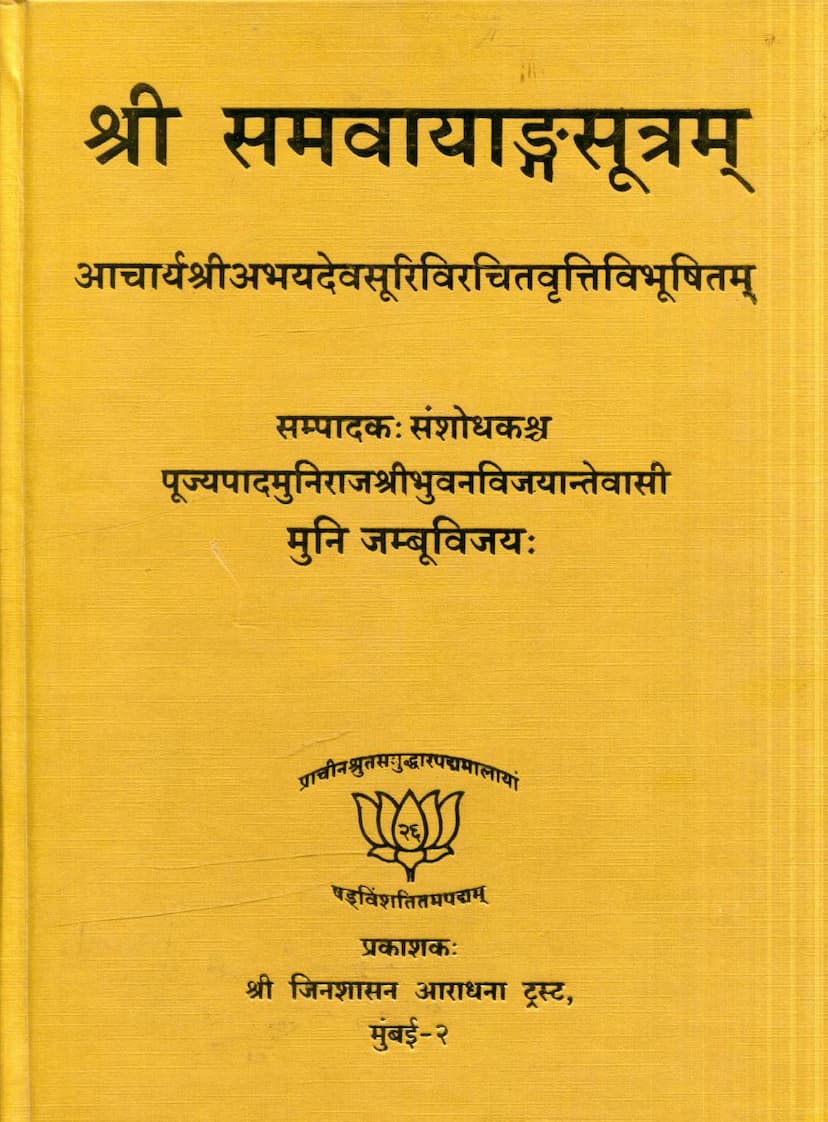Samvayang Sutram
Added to library: September 2, 2025

Summary
The provided text is the beginning pages of the Samvayang Sutram, a Jain scripture, along with its commentary. Here's a comprehensive summary in English based on the provided pages:
Book Title: Samvayang Sutram Author(s): Jambuvijay (editor/compiler) Publisher: Shri Jinshasan Aradhana Trust, Mumbai Catalog Link: https://jainqq.org/explore/032089/1
Key Information and Context:
- Title: The text is identified as "Shri Samvayang Sutram," a significant scripture within the Jain canon.
- Commentary: It is highlighted that the text is enriched with the commentary ("Vrittivibhushitam" / "Vivaranavibhushitam") composed by Acharya Shri Abhaydev Suri.
- Lineage: The text is stated to be received from the lineage of the fifth Ganadhara, Shri Sudharma Swami.
- Editor/Compiler: Munishri Jambuvijay is credited as the primary editor and re-compiler. He is identified as a disciple of Munishri Bhuvanvijay, who was associated with Jinshrut Samvardhan Palamala.
- Re-discovery/Preservation: The preface emphasizes the effort in collecting and collating ancient manuscripts ("prācīna-prācīnatara-prācīnatama vividha hastalikhita darśānusāreṇa") to create this edition. This points to a scholarly effort to preserve and present the scripture based on various old manuscripts.
- Dedication: The publication is dedicated to the memory of Nyaas Pravar Shri Padmvijay Ganivar and is part of the "Shri Prachin Shrut Samuddhar Padma Mala" (A Garland of Lotuses for the Revival of Ancient Scriptures).
- Sponsorship: The publication was made possible through the financial assistance of Shri Premvardhak Jain Shwetamber Mo. Pu. Sangh, Paldi, and mentions numerous other organizations and individuals who supported the "Shruta Samuddhar" (Revival of Scriptures) initiative.
- Ownership and Authority: It is explicitly stated that the ownership of the text belongs to the Shri Jain Shwetamber Moortipujak Tapa Gacch Sangh. The authority to read and teach this text is vested in monks who have received proper instruction and permission from their gurus.
- Structure and Content:
- The initial pages contain introductory remarks, acknowledgments, and a table of contents or index ("Vishayanukramah").
- The index lists the contents of the Samvayang Sutram, detailing various categories and subjects covered within the text, often numbered or categorized numerically (e.g., from 1-160, with sub-points).
- The index suggests that the Samvayang Sutram is a highly systematic and classificatory text, detailing numerous concepts, elements, numbers, and classifications within Jain philosophy. Topics include:
- Danda, Rashi, Bandhana, Nakshatra, Shvasa, Aahara, Siddhi: These appear to be recurring categories or analytical frameworks.
- Leshya, Jivnikaya, Tapa, Samudghata, Arthavagraha: Mentioned in various contexts.
- Vimana, Pṛthvi, Lok, Adholoka, Aloka: Cosmological and spatial concepts.
- Kashaya, Dhyana, Vikatha, Sanjnya: Aspects of the soul's state and practices.
- Mahavrata, Samiti, Gupit: Ethical conduct and discipline.
- Deva, Naraka, Jiva, Pudgala: Fundamental Jain ontological categories.
- Karmas: Detailed classification of karmic bondage and its aspects.
- Tirthankaras, Ganadharas: Biographies and classifications of spiritual leaders.
- Chronological periods: References to time, eras, and lifespans (e.g., of deities, beings).
- Cosmic elements: Details about the universe, mountains, rivers, continents (e.g., Jambudvipa, Lavana Samudra).
- Specific numbers: The text seems to enumerate and classify things based on numbers, starting from one up to significant figures (the index goes up to details related to 60+ items in the lists).
- Commentary Style: The commentary by Abhaydev Suri appears to be detailed, explaining the meanings of terms, providing scriptural references, and clarifying intricate points, often referring to other texts or usages ("Vachana") and offering explanations of terminology.
- Editorial Notes: There are editorial notes (indicated by numbers 1, 2, 3, etc.) that provide details about manuscript variations or sources.
Core Nature of Samvayang Sutram (as inferred from the introduction and index):
The Samvayang Sutram is a foundational text in Jainism, likely belonging to the Angas or Upangas (mentioned as the fourth Anga). Its primary function, as suggested by its name (Sam + Avayanga = "coming together" or "classification") and the extensive index, is to systematically classify and relate various Jain doctrines, concepts, entities, and phenomena. It likely provides a framework for understanding the interconnectedness of Jain teachings, covering a vast range of topics from cosmology and ontology to ethics, karma, and spiritual paths. The numerical structure indicated in the index suggests a highly organized and analytical approach to presenting Jain knowledge. The detailed commentary by Abhaydev Suri indicates its importance and the need for in-depth explanation for scholars and practitioners.
In essence, the provided pages offer a glimpse into a scholarly edition of a key Jain scripture, emphasizing its scriptural lineage, the critical work of its editors, and the vast, systematic knowledge base it contains.